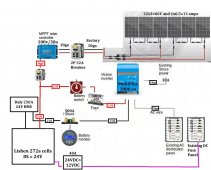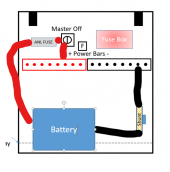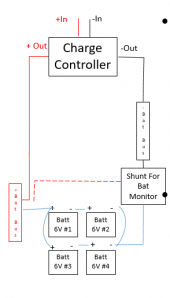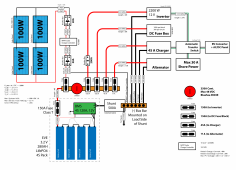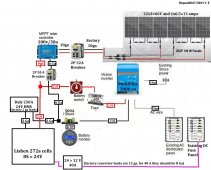Stepandwolf
Solar Enthusiast
- Joined
- Nov 14, 2020
- Messages
- 668
Saw the great help others got here, let me show you my diagram as it is now. I suspect there will be comments on fuses and gauges, and every thing else too 

As of now, the panels are a bit uncertain as what I wanted wasn't available and then became available. In another topic, I will ask for help with panel configuration, but for sake of the current design, it is six 100w panels wired 3s2p. The specs for the panels are "max 600vdc, open ckt 21.6V, optimum 5.56A Short-Circuit 6.5A, series fuse rating 15A". I hope that gibberish means something to someone .
.
My diagram shows an 8ga wire from the DC>DC as it is rated at 40A, however the wires in and out of the converter are 12 GA. Don't know if that means I can safely use 12ga wires or connect 8ga to their 12ga?
Any help will be appreciated.

As of now, the panels are a bit uncertain as what I wanted wasn't available and then became available. In another topic, I will ask for help with panel configuration, but for sake of the current design, it is six 100w panels wired 3s2p. The specs for the panels are "max 600vdc, open ckt 21.6V, optimum 5.56A Short-Circuit 6.5A, series fuse rating 15A". I hope that gibberish means something to someone
My diagram shows an 8ga wire from the DC>DC as it is rated at 40A, however the wires in and out of the converter are 12 GA. Don't know if that means I can safely use 12ga wires or connect 8ga to their 12ga?
Any help will be appreciated.



